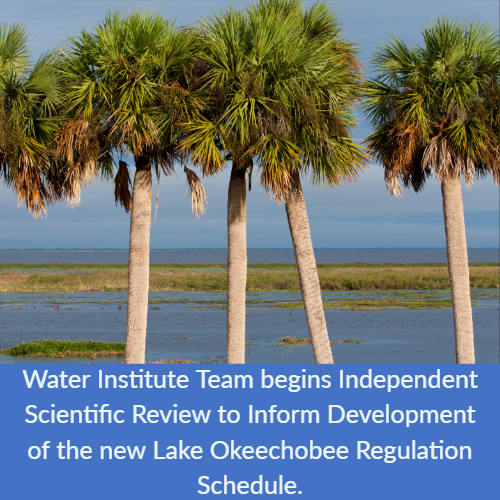Water Institute Team begins Independent Scientific Review to Inform Development of the new Lake Okeechobee Regulation Schedule.
The South Florida Water Management District (SFWMD) has contracted with the University of Florida Water Institute (UF WI) to conduct an independent scientific review to help inform the development of the next Lake Okeechobee Regulation Schedule.
The UF WI has convened an interdisciplinary academic review team that will: (1) acquire and synthesize existing scientific information related to the impacts of the Lake Okeechobee regulation schedule on the ecology of Lake Okeechobee and the estuaries that receive lake discharges; (2) identify knowledge gaps and additional data needed to assess the ecological impacts and tradeoffs of proposed changes to LORS; and (3) develop recommendations and priorities for new efforts needed to fill gaps in existing knowledge. In particular the team will focus on effects of lake stage on the ecology of Lake Okeechobee, effects of lake discharge on Estuarine Conditions, and how climate change, climate variability and sea level rise could impact tradeoffs between the health of the lake, estuaries, Everglades, as well as the provision of flood control and water supply. The scientific review team consists of:
- Wendy Graham, Director, UF Water Institute (Project Leader)
- Mark Brenner, Professor, UF Geologic Sciences
- Karl Havens, Director, Florida Sea Grant College Program
- Jim Fourqurean, Director, FIU Center for Coastal Oceans Research
- Jayantha Obeysekera, Director, FIU Sea Level Solutions Center
Tom Frazer, one of the original team members, will participate with the team in an ex-officio capacity due to his new role as the State of Florida’s Chief Science Officer.
The south Florida regional landscape has been engineered to provide flood protection and water supply. Lake Okeechobee is the main location for surface water storage in this system. Historically, no water flowed from Lake Okeechobee to the St. Lucie on the east coast, and only a small amount of water flowed to the Caloosahatchee on the west coast. As part of the Central and Southern Florida (C&SF) Project authorized in 1948 the system was s engineered with two large canals that now have the capacity to carry large volumes of water from Lake Okeechobee to the St. Lucie and the Caloosahatchee estuaries. Considerable impacts to the natural ecosystems of south Florida, including the St. Lucie Estuary, Caloosahatchee Estuary, Lake Okeechobee, and the Florida Everglades stem from large deviations in the quantity and quality of freshwater delivered to these systems relative to a pre-engineered time period.
Lake Okeechobee is regulated and managed, in large part, by the U.S. Army Corps of Engineers (USACE). The SFWMD cooperates with the USACE providing information relevant to the Lake’s management. The USACE and SFWMD are planning a lake regulation review that will consider alternative regulation schedules that take into consideration the tradeoffs between health of the lake, estuaries, Everglades, as well as provision of flood control and water supply.


